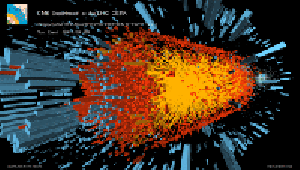www.yazdparticles.ir
Nov 11, 2010
CERN completes transition to lead-ion running at the LHC
Geneva, 8 November 2010. Four days is all it took for the LHC operations team at CERN to complete the transition from protons to lead ions in the LHC. After extracting the final proton beam of 2010 on 4 November, commissioning the lead-ion beam was underway by early afternoon. First collisions were recorded at 00:30 CET on 7 November, and stable running conditions marked the start of physics with heavy ions at 11:20 CET today.
“The speed of the transition to lead ions is a sign of the maturity of the LHC,” said CERN Director General Rolf Heuer. “The machine is running like clockwork after just a few months of routine operation.”
Operating the LHC with lead ions – lead atoms stripped of electrons - is completely different from operating the machine with protons. From the source to collisions, operational parameters have to be re-established for the new type of beam. For lead-ions, as for protons before them, the procedure started with threading a single beam round the ring in one direction and steadily increasing the number of laps before repeating the process for the other beam. Once circulating beams had been established they could be accelerated to the full energy of 287 TeV per beam. This energy is much higher than for proton beams because lead ions contain 82 protons. Another period of careful adjustment was needed before lining the beams up for collision, and then finally declaring that nominal data taking conditions, known at CERN as stable beams, had been established. The three experiments recording data with lead ions, ALICE, ATLAS and CMS can now look forward to continuous lead-ion running until CERN’s winter technical stop begins on 6 December.
“It's been very impressive to see how well the LHC has adapted to lead ions,” said Jurgen Schukraft, spokesperson of the ALICE experiment. “The ALICE detector has been optimised to record the large number of tracks that emerge from ion collisions and has handled the first collisions very well, so we are all set to explore this new opportunity at LHC.”
“After a very successful proton run, we’re very excited to be moving to this new phase of LHC operation,” said ATLAS spokesperson Fabiola Gianotti. “The ATLAS detector has recorded first spectacular heavy-ion events, and we are eager to study them in detail.”
“We designed CMS as a multi-purpose detector,” said Guido Tonelli, the collaboration’s spokesperson, “and it’s very rewarding to see how well it’s adapting to this new kind of collision. Having data collected by the same detector in proton-proton and heavy-ion modes is a powerful tool to look for unambiguous signatures of new states of matter.”
Lead-ion running opens up an entirely new avenue of exploration for the LHC programme, probing matter as it would have been in the first instants of the Universe’s existence. One of the main objectives for lead-ion running is to produce tiny quantities of such matter, which is known as quark-gluon plasma, and to study its evolution into the kind of matter that makes up the Universe today. This exploration will shed further light on the properties of the strong interaction, which binds the particles called quarks, into bigger objects, such as protons and neutrons.
Following the winter technical stop, operation of the collider will start again with protons in February and physics runs will continue through 2011.
LHC protons 2010: mission accomplished
When we started running the LHC at the end of March, we set ourselves the objective of reaching a luminosity of 1032 by the end of 2010 proton running. Last night, we achieved that goal. The beams that went in at around 2:00am, were colliding with a luminosity of 1.01 ´1032 by 3:38am in both ATLAS and CMS, and had delivered an integrated luminosity of over 2 inverse picobarns to ATLAS, CMS and LHCb by midday today. It’s a great achievement by all concerned to reach this important milestone with over two weeks to spare. The remainder of this year’s proton running will be devoted to maximising the LHC 2010 data set and preparing for 2011 proton running before we switch to lead ions in November.
The significance of this milestone can’t be underestimated, since it is a necessary step on the way to the larger goal of delivering an integrated luminosity of one inverse femtobarn to the experiments by the end of 2011. That’s the amount of data we need to ensure that if nature has put new physics in our path at the LHC’s current collision energy, we’ll have a good chance of seeing it.
At the moment, we’re running the LHC with 248 bunches per beam in a configuration that allows us to go much higher. As 2011 proton running gets underway early next year we’ll continue increasing the number of bunches, since a factor of two or so more luminosity is still needed if we’re to reach our one inverse femtobarn goal. That, however, is for next year. In the meantime, the objective we set ourselves for this year was realistic, but tough, and it’s very gratifying to see it achieved in such fine style.
Subscribe to:
Posts (Atom)
